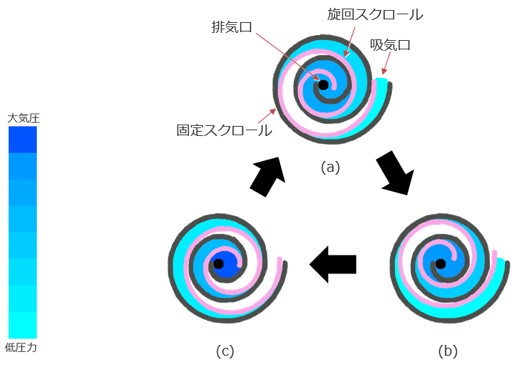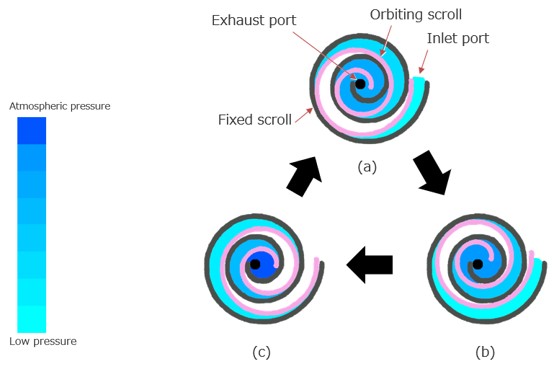ドライスクロール真空ポンプ
ドライスクロール真空ポンプ
dry scroll vacuum pump
[目次:装置]
オイルを使わずに渦巻(スクロール)状の部品を旋回させて気体を圧縮しながら排出し、目的の装置を大気圧から数Paまで排気するオイルフリーの真空ポンプ。SEMではターボ分子ポンプの補助(バッキング)ポンプとして用いられる。
ポンプは固定スクロールと旋回スクロールを備えている。固定スクロールと旋回スクロールの中心は少しずれており、二つのスクロールの間には渦巻状の間隙(溝)ができている。固定スクロールと旋回スクロールには真空を保つためのチップシールが取り付けられている。旋回スクロールを固定スクロールに対して旋回させるとチップシールが相手のスクロールとこすり合わさるように動く。気体は吸気口から引き込まれ、スクロールの間隙に閉じ込められ、中心に向かって圧縮されながら中心にある排気口へ押し出される。

図1 スクロールの動き
旋回スクロールをピンクで、固定スクロールを黒線で示した。水色はポンプ内へと引き込まれた気体を表す。旋回スクロールが固定スクロールに対して旋回すると、気体は圧縮されながら中心にある排気口に向かって運ばれ排出される。中心部の気体の圧力は高いので濃い水色で示した。
旋回スクロールが動くと吸気口が開き、気体が旋回スクロールと固定スクロールの間隙に導入される (図1a,b)。旋回が進むと、旋回スクロールの壁が固定スクロールに近接し吸気口を閉じる(図1c)、間隙部分は中心方向に動いてゆき、気体は中心部に運ばれ(濃い青で示した)、中心に位置する排気口へ押し出される(図1c)。引き続いて、吸気口が開き次の気体がポンプ内へ引き込まれる(図1a)。この一連の動きを繰り返すことで吸気口側の気体が引き続けられる。
図2に旋回スクロールと固定スクロールの断面図を示す。ピンクは旋回スクロール、黒は固定スクロール、薄緑はチップシールと呼ばれる樹脂製の部品である。チップシールは固定スクロールと旋回スクロールに装着され、旋回スクロールの壁と固定スクロールの壁でできた空間を気密に保つ。チップシールは消耗品であり、ポンプの性能を維持するために定期的に交換する必要がある。

図2 スクロールとチップシール
二つのスクロールに装着したチップシールが相手のスクロールに密着することで、旋回スクロールと固定スクロールの間に気体を閉じ込められる。閉じ込められた気体の圧力は中心に向かうほど高くなる。圧力の高い気体を濃い水色で、低い気体を薄い水色で示した。
スクロールポンプは、大気の汚染が直接問題になる半導体製造現場におけるクリーンルーム、廃棄物処理が難しい原子力施設や放射線利用施などで有効に使われる。また、油回転真空ポンプに用いる油は可燃性であるため、安全管理の面からオイルフリーなスクロールポンプの需要がある。
The dry scroll vacuum pump is an oil-free vacuum pump that compresses and exhausts gases by rotating the orbiting scroll, and evacuates the target device from atmospheric pressure to a vacuum of a few Pa. In a SEM, the dry scroll vacuum pump is used as a backing pump for the turbo-molecular pump (TMP).
The pump is equipped with a fixed scroll and an orbiting scroll. The centers of the fixed scroll and orbiting scroll are slightly off-center, creating a spiral gap (groove) between the two scrolls. The tip seals are attached to the fixed and orbiting scrolls to keep the spiral gap airtight. When rotating the orbiting scroll against the fixed scroll, the tip seals move to rub against the opposing scroll. The gas is drawn in from the inlet port and trapped in the gap between the scrolls. Then, it is carried to the center while being compressed and is pushed to the exhaust port located at the center.

Fig. 1. Schematic of the movement of the orbiting scroll
The orbiting scroll and the fixed scroll are displayed by pink lines and black lines, respectively. Gas drawn in and trapped in the gap created between the two scrolls is displayed by light blue. When the orbiting scroll rotates against the fixed scroll, the gas is carried to the center while being compressed, and then the gas is pushed to the exhaust port located at the center. As the pressure of the gas near the center is higher, it is displayed by dark blue.
As the orbiting scroll rotates, the inlet port opens, and gas is introduced into the gap between the orbiting and fixed scrolls (Fig. 1a, b). As the rotation continues, the orbiting scroll comes close to the fixed scroll and closes the inlet port, and the gap between the two scrolls moves toward the center, carrying the gas to the center (shown in dark blue). Then, the gas is pushed out to the exhaust port located at the center (Fig. 1c). The inlet port then opens, and the next gas is drawn into the pump (Fig. 1a). This sequence of rotations is repeated to continue pumping of gas of the device at the inlet port side.
Fig. 2 illustrates a schematic of the cross section of the orbiting scroll and the fixed scroll. Pink color indicates the orbiting scroll, black does the fixed scroll, and light-green colors indicate the tip seals made of resin. The tip seals are attached to both the fixed scroll and orbiting scroll, which keep the space (gap) created by both the scrolls airtight. Tip seals are consumable and should be regularly replaced with new ones to maintain the performance of the pump.

Fig. 2. Scrolls and tip seals
Tip seals attached to the two scrolls contact the opposing scroll to trap gas between the orbiting and fixed scrolls. The pressure of the gas increases toward the center. Gas with higher pressure is shown in dark blue and gas with lower pressure is shown in light blue.
The dry scroll vacuum pump is effectively used in clean rooms of semiconductor manufacturing sites, where air pollution causes a direct problem, and in nuclear facilities and radiation facilities, where waste disposal is difficult. In addition, as oil used in oil-sealed rotary vacuum pumps is flammable, the oil-free scroll pump is highly recommended from the point of safety management.
説明に「ドライスクロール真空ポンプ」が含まれている用語






